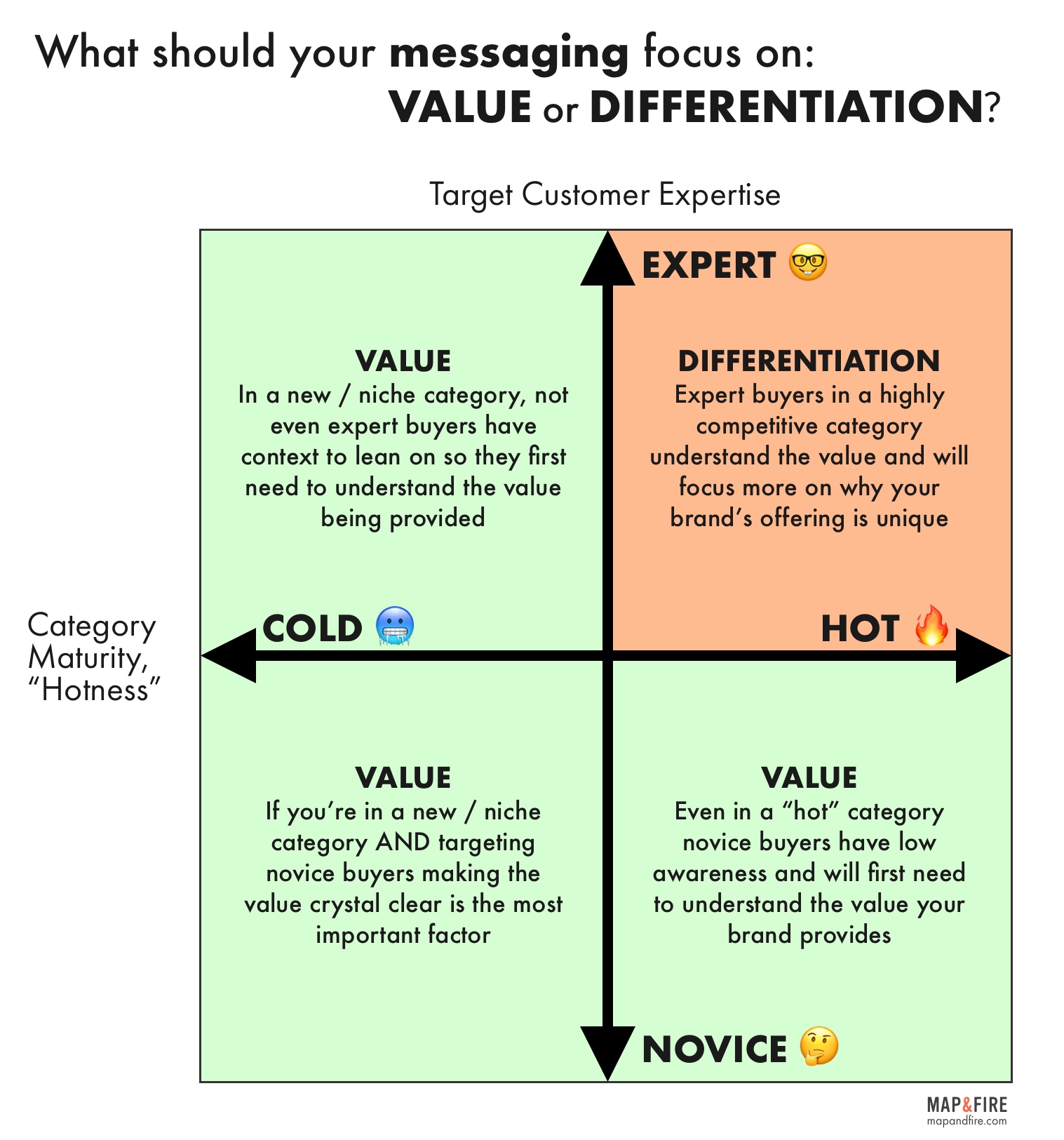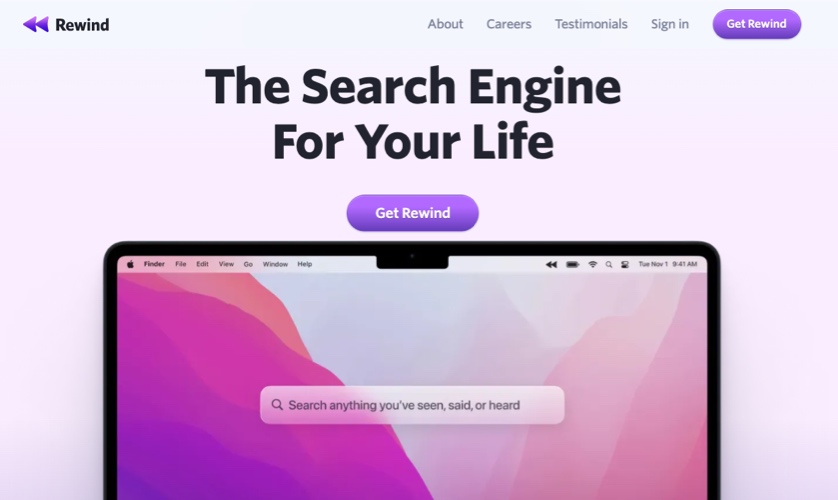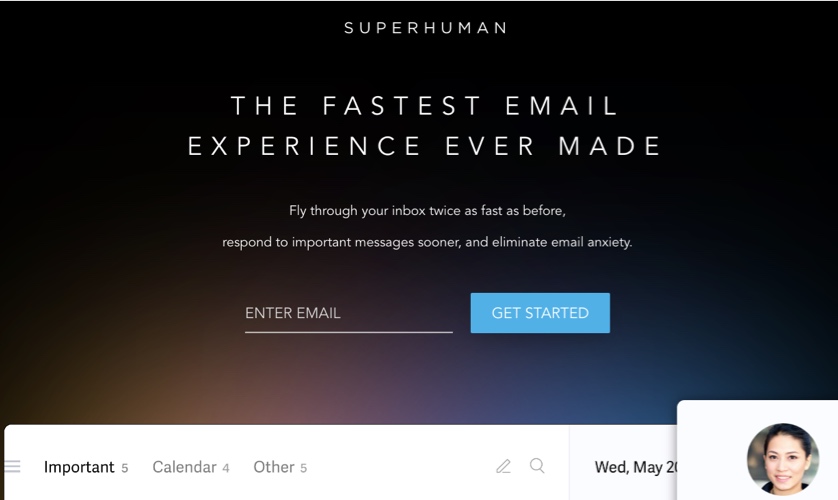
There’s a well discussed idea in branding that key messages should focus on the customer benefits of an offering rather than its features.
In other words, the lead message centers on the value the customer receives.
The logic here is that you’re speaking about the product or service from the customer’s perspective. You’re speaking to how their life will improve as a result of engaging with the brand.
By doing this, you keep the customer from having to do any mental heavy lifting around how an offering is valuable to them. It focuses messages on the outcomes they want.
This approach saves the person from having to first understand the offer and then decipher how it might fit in their life. You’re doing that work for them.
But like any good rule, there are always exceptions.
In certain situations, putting a stronger emphasis on differentiation through features can be an effective approach.
There are two factors to consider that can help determine whether focusing your key messaging on benefits and value, or features and differentiation is the better strategy for your brand.
Factor 1: Maturity Of Your Category

Your brand’s offering (i.e. your product or service) is typically part of a known category. And the category you’re in can range anywhere from small or new, to massive and mature.
Examples that show the spectrum of categories in the business world are:
- AI-assisted writing tools – small (but growing) category that’s quite new
- Project Management tools – huge category that’s been around for many years
Strategy consultant, Dave Kellogg, refers to the variance of these as “cold” and “hot” markets.
In a small or “cold” market, it’s likely that most customers won’t be familiar with the benefits you provide. They may have never explored a solution in your category or heard of it all.
This means educating them about the value of your offering is critical.
On the flip side, in a super mature category that’s well integrated into people’s lives, it’s likely that the customers have some awareness of the space.
In this case, talk of basic benefits and value could be a waste of time. Their decision making process centers more on the specific features of the offering. That’s the information they need to differentiate one brand from another.
Using the example above, the customer knows that all project management software aims to keep them organized and on schedule. But which one has the most intuitive task tracker? And will it integrate with their CRM?
For this type of category, incorporating features into your key messaging could help a customer remember your brand’s position.
But still just because a category is mature, it doesn’t mean your customer is an expert.
Which leads us to the second factor.
Factor 2: Sophistication Of Your Customer

While it’s more likely that a mature category will have a higher ratio of knowledgeable, expert-level customers, it won’t always be the case.
Your brand may even be intentionally targeting novice customers within a mature market.
Going back to the project management example again, your brand might offer a project management tool for small businesses – or first time users.
So, despite operating in a very mature, “hot” category your target customers are novice in their understanding.
This segment still needs a value message because they’re not familiar yet with the core benefits of the category.
Find Your Key Messaging Strategy On The Grid
To clarify how these two factors work together, we created a simple framework to visualize each combination.

In the grid we see the four possible combinations:
- Expert Customer + Cold Market = VALUE: In a new / niche market, even expert customers need a message that centers first on value
- Expert Customer + Hot Market = DIFFERENTIATION: In a competitive market, expert buyers may be more interested in specific features to help them understand and remember what makes your offering unique
- Novice Customer + Cold Market = VALUE: With a new / niche market and a novice customer a focus on value is a must
- Novice Customer + Hot Market = VALUE: If you target novice customers within a competitive market it’s still important to lead with value
Examples of Each Key Messaging Strategy
Here are two growing brands taking distinct approaches in their key messaging strategy.
Value Messaging Example
On the value strategy side we have Rewind:

Rewind has developed a new product that records all the activity on your computer – from web browser, to documents, to video calls, to chat. It then allows you to search any of that content to revisit conversations and access information that might otherwise be very difficult to locate.
This “life search engine” is a totally new, “cold” category. Whether a customer has expertise in related areas or not doesn’t matter. Rewind’s primary focus with its messaging has to be on expressing the value of the product.
This ensures that a new customer has some context for what the product does and how it delivers relevant outcomes.
Further into the site, Rewind digs into features but only after establishing the primary story of value.
Differentiation Messaging Example
In contrast, here’s the messaging for Superhuman:

Superhuman operates in one of the most mature tech categories imaginable – email.
Everyone who uses a computer (or phone, tablet, smartwatch, etc) has an email address.
But Superhuman isn’t targeting every single person who uses email. They’re focused on email power users. These people aim to squeeze every bit of efficiency they can out of their email experience. They know the pluses and minuses of every system and have strong opinions about them.
In other words, these people are email experts.
Aligning to this market and target customer, Superhuman focuses on a key central feature of their product – speed.
You can argue about what the most important features are for email – in fact we wrote a whole article about this very topic. But what’s most important is that Superhuman doesn’t waste time explaining why email as a category provides value. Their focus is on Superhuman’s differentiation.
Benefits And Features Both Have A Role In Messaging

Even though this discussion presents value and differentiation as binary choices, it doesn’t mean your messaging should only address one or the other.
Effective messaging for any brand should use both benefits and features to paint a complete picture of what’s offered.
If your messaging leads with value and benefits, you’ll still want supporting messaging that breaks down points of differentiation.
Once a customer gains awareness of the value they’re likely to investigate and compare alternative solutions. At that stage in the buying journey, specific features can help your offer stand apart. At that point, your novice customer becomes more of an expert.
Conversely, even expert customers in a “hot” market get driven by emotion in their decision making. They still need to envision how their lives will improve with your brand. Sprinkling in support of value and benefits helps paint that picture for even the most pragmatic individuals.
The big takeaway is that to communicate effectively with your customers you need to appreciate and consider the offering from their perspective. How well known is the market? How educated are your target customers about the category?
Once you have that in mind you can find the right balance of value and differentiation to meet them at the right point in their journey and get them to buy.

Get Help Crafting Memorable Key Messages
If you’re ready to build stronger connections with your customers, reach out for a free consultation. We’ll help you transform your best business thinking into an actionable, shareable, growth-oriented guide. Click below to learn more about the Brand Guidebook process.

